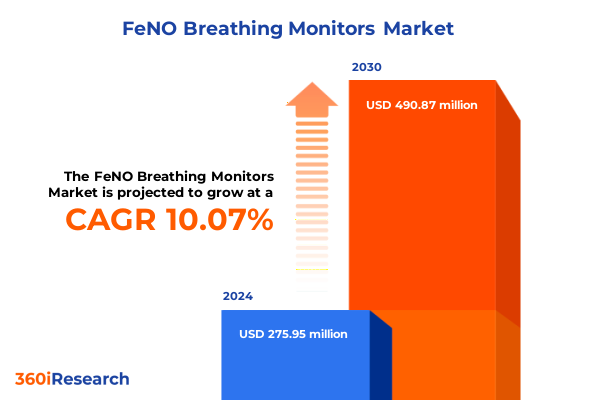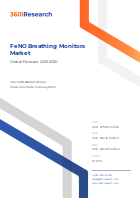The FeNO Breathing Monitors Market size was estimated at USD 275.95 million in 2024 and expected to reach USD 303.10 million in 2025, at a CAGR 10.07% to reach USD 490.87 million by 2030.

Introduction to FeNO Breathing Monitoring Innovations
FeNO breathing monitors have emerged as a pivotal tool in respiratory care, offering a non-invasive method to quantify airway inflammation through fractional exhaled nitric oxide measurements. As asthma and other inflammatory airway diseases continue to impose a significant clinical and economic burden, these devices enable clinicians to tailor treatment plans more accurately, reduce exacerbation risks, and improve patient adherence. Recent advancements in sensor technology have elevated both the sensitivity and portability of breath analyzers, allowing for seamless integration into both clinical and homecare settings. In parallel, growing emphasis on personalized medicine has positioned FeNO monitoring at the forefront of disease management strategies. By delivering real-time feedback and empowering patients with actionable data, these innovations foster proactive care, bridging the gap between episodic clinical visits and continuous disease surveillance. This introduction sets the stage for a comprehensive examination of the latest shifts reshaping the FeNO monitor landscape, ensuring decision-makers are equipped with the insights needed to capitalize on emerging opportunities and navigate evolving challenges.
Transformative Shifts Driving the FeNO Monitor Landscape
The landscape of FeNO breathing monitors is undergoing transformative shifts driven by rapid technological convergence and evolving clinical paradigms. First, the convergence of miniaturized chemiluminescence and electrochemical sensors has enabled manufacturers to strike a balance between high analytic precision and cost-effective production. Meanwhile, the growing adoption of wireless connectivity and smartphone integration allows patients to share longitudinal data with care teams, fostering remote management and telehealth initiatives. Regulatory bodies are also playing a pivotal role: expedited pathways for digital health devices have reduced market entry timelines, while updated guidelines on nitric oxide measurement standards ensure consistent performance across diverse populations.
Moreover, artificial intelligence and machine learning are being harnessed to interpret FeNO trends, alerting clinicians to subtle deviations that precede clinical deterioration. In tandem, partnerships between device innovators and pharmaceutical companies are emerging, with joint clinical trials validating FeNO monitoring as a biomarker for novel anti-inflammatory therapies. These collaborative efforts underscore a broader shift toward value-based care, where reimbursement models increasingly reward demonstrable improvements in patient outcomes and cost efficiencies. As a result, stakeholders across the value chain-from component suppliers to end users-must embrace these dynamic forces to maintain competitive advantage and deliver superior respiratory care.
Assessing the Impact of New U.S. Medical Device Tariffs in 2025
The introduction of new United States tariffs in 2025 on selected medical device imports has reverberated throughout the FeNO monitor supply chain. Component costs for imported chemiluminescence sensors and specialized microchips have risen, prompting some multinational manufacturers to reassess production footprints and explore nearshoring opportunities. In response, several industry players have strengthened partnerships with domestic suppliers and invested in local assembly lines to mitigate exposure to import levies.
Concurrently, these tariffs have accelerated consolidation among small and mid-sized suppliers, as the increased cost burden has strained margins and compelled businesses to evaluate strategic alliances. While some global vendors have absorbed additional expenses to preserve price stability for end users, others have passed through incremental costs, leading to concentrated pockets of price sensitivity in both hospital procurement and homecare markets.
Ultimately, the cumulative impact of these trade measures highlights the critical importance of supply chain resilience. Manufacturers that proactively diversify sourcing and streamline logistics stand to minimize disruption, secure cost predictability, and sustain product availability in an environment marked by fluctuating trade policies.
Key Segmentation Insights Across Technology, Age, and Application
Segmentation analysis reveals distinct opportunities and challenges across technology, patient age, warning signals, distribution channels, applications, and end users. By technology, high-precision chemiluminescence sensors continue to dominate clinical workflows due to their superior sensitivity, while the growing affordability of electrochemical sensors expands adoption in resource-constrained settings. Age-based considerations show robust FeNO adoption among adults managing chronic asthma, with geriatrics benefitting from integrated monitoring in ambulatory settings and pediatric applications requiring tailored, low-volume sampling for infants and toddlers. Dual warning modalities-audible beeps and visual light indicators-enhance user compliance, as patients and caregivers can choose the interface best suited to mobility or sensory needs.
Distribution channels further segment the market into offline and online pathways, with traditional hospital procurement coexisting alongside digital commerce models. Online penetration is driven by brand websites and eCommerce platforms that offer subscription models and direct-to-patient delivery, smoothing access for homecare users. Clinical applications span allergic rhinitis screening, acute and chronic asthma management, chronic obstructive pulmonary disease monitoring, and broader respiratory distress detection, cementing FeNO monitors as versatile diagnostic adjuncts. Finally, end-user settings range from ambulatory clinics and hospitals to homecare environments and research laboratories, each demanding tailored device features-from portability and connectivity to data security and compliance with institutional protocols.
This comprehensive research report categorizes the FeNO Breathing Monitors market into clearly defined segments, providing a detailed analysis of emerging trends and precise revenue forecasts to support strategic decision-making.
- Technology
- Patient Age Group
- Warning Signal
- Distribution Channel
- Application
- End User
Regional Dynamics Shaping FeNO Monitor Adoption
Regional dynamics underscore varied uptake patterns and growth drivers. In the Americas, strong institutional investment in respiratory health and widespread reimbursement frameworks underpin widespread FeNO integration in both hospital and outpatient settings. Conversely, Europe, the Middle East, and Africa exhibit heterogeneous demand, with Western European markets leveraging robust clinical guidelines to adopt FeNO monitoring, while emerging economies in the Middle East and Africa emphasize cost-effective electrochemical solutions to expand diagnostic coverage. In the Asia-Pacific region, escalating asthma prevalence, rising disposable incomes, and state-led health initiatives are fueling rapid penetration, especially in urban centers across China, Japan, and Australia. Digital health infrastructure maturity in these markets also accelerates the deployment of connected FeNO devices, creating pathways for large-scale public health monitoring programs.
This comprehensive research report examines key regions that drive the evolution of the FeNO Breathing Monitors market, offering deep insights into regional trends, growth factors, and industry developments that are influencing market performance.
- Americas
- Asia-Pacific
- Europe, Middle East & Africa
Competitive Landscape and Leading Industry Players
Industry competition is anchored by established and emerging players, each leveraging unique strengths to capture market share. Bedfont Scientific Ltd. distinguishes itself through decades of chemiluminescence expertise and a global clinical trial portfolio, while Bosch Healthcare Solutions GmbH leverages its electronics heritage to deliver connected, modular monitoring platforms. CAIRE Inc. focuses on integrated respiratory solutions spanning oxygen therapy and FeNO monitoring, creating synergistic care pathways. COSMED srl champions portable, user-friendly analyzers that meet stringent European quality standards, and e-LinkCare Meditech Co.,Ltd. addresses price-sensitive markets with streamlined electrochemical devices.
ECO MEDICS AG integrates advanced analytics and cloud-based data management, reinforcing its presence in research settings. MGC Diagnostics Corporation combines pulmonary function testing with FeNO capabilities, offering comprehensive respiratory solutions. NIOX Group plc, a pioneer in bedside nitric oxide measurement, continues to innovate with compact, patient-centric designs, while Vitalograph Ltd. expands its footprint through partnerships that embed FeNO monitoring into telehealth and clinical trial platforms. Collectively, these companies drive innovation, expand distribution networks, and shape standards, reinforcing the overall market’s technological and service excellence.
This comprehensive research report delivers an in-depth overview of the principal market players in the FeNO Breathing Monitors market, evaluating their market share, strategic initiatives, and competitive positioning to illuminate the factors shaping the competitive landscape.
- Bedfont Scientific Ltd.
- Bosch Healthcare Solutions GmbH
- CAIRE Inc.
- COSMED srl
- e-LinkCare Meditech Co.,Ltd.
- ECO MEDICS AG
- MGC Diagnostics Corporation
- NIOX Group plc
- Vitalograph Ltd.
Actionable Recommendations for FeNO Monitor Industry Leaders
Industry leaders can capitalize on emerging trends by implementing several strategic actions. First, investing in flexible manufacturing and dual-sourcing strategies will safeguard against tariff-related disruptions and ensure uninterrupted supply. Second, integrating AI-driven analytics within FeNO platforms can differentiate product offerings and deliver actionable clinical insights, promoting value-based care agreements. Third, forging alliances with telehealth providers and patient-management platforms will expand digital distribution channels and heighten patient engagement, especially in homecare settings.
Additionally, customizing device interfaces and sampling protocols to address pediatric and geriatric needs can unlock new end-user segments, while collaborating with regional distributors can tailor go-to-market approaches in diverse regulatory landscapes. Finally, establishing joint research initiatives with academic centers to validate FeNO monitoring as a predictive biomarker for emerging therapies will strengthen reimbursement positioning and accelerate adoption.
Explore AI-driven insights for the FeNO Breathing Monitors market with ResearchAI on our online platform, providing deeper, data-backed market analysis.
Ask ResearchAI anything
World's First Innovative Al for Market Research
Conclusion: Navigating a Dynamic FeNO Monitor Ecosystem
FeNO breathing monitors stand poised at the intersection of technological innovation and evolving clinical demands. The convergence of high-performance sensors, digital health integration, and value-based care imperatives has created a fertile environment for growth. However, external pressures-ranging from tariff adjustments to shifting regulatory frameworks-underscore the need for strategic agility. By leveraging detailed segmentation insights and regional market intelligence, stakeholders can tailor product portfolios and distribution strategies to meet diverse clinical and patient requirements. Strategic partnerships, targeted R&D investments, and supply chain diversification will be critical to sustaining momentum and capturing future opportunities in this dynamic market.
This section provides a structured overview of the report, outlining key chapters and topics covered for easy reference in our FeNO Breathing Monitors market comprehensive research report.
- Preface
- Research Methodology
- Executive Summary
- Market Overview
- Market Dynamics
- Market Insights
- Cumulative Impact of United States Tariffs 2025
- FeNO Breathing Monitors Market, by Technology
- FeNO Breathing Monitors Market, by Patient Age Group
- FeNO Breathing Monitors Market, by Warning Signal
- FeNO Breathing Monitors Market, by Distribution Channel
- FeNO Breathing Monitors Market, by Application
- FeNO Breathing Monitors Market, by End User
- Americas FeNO Breathing Monitors Market
- Asia-Pacific FeNO Breathing Monitors Market
- Europe, Middle East & Africa FeNO Breathing Monitors Market
- Competitive Landscape
- ResearchAI
- ResearchStatistics
- ResearchContacts
- ResearchArticles
- Appendix
- List of Figures [Total: 28]
- List of Tables [Total: 412 ]
Contact Ketan Rohom to Access the Comprehensive FeNO Monitor Market Report
To gain deeper insights into FeNO monitor advancements and secure a competitive edge, contact Ketan Rohom, Associate Director, Sales & Marketing. Discover how this comprehensive market research report can inform your strategic planning and drive growth. Reach out today to discuss tailored solutions and unlock critical data for informed decision-making.

- How big is the FeNO Breathing Monitors Market?
- What is the FeNO Breathing Monitors Market growth?
- When do I get the report?
- In what format does this report get delivered to me?
- How long has 360iResearch been around?
- What if I have a question about your reports?
- Can I share this report with my team?
- Can I use your research in my presentation?




